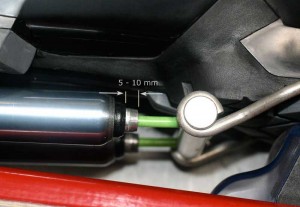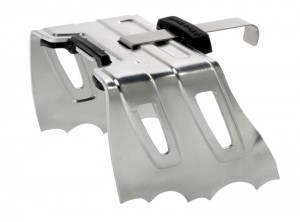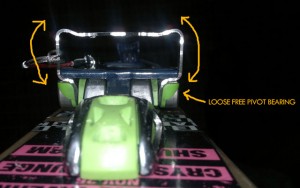O1 quirks and blemishes:
1) ALWAYS check the pretension before heading down or 2) use some plumbers tape on the threads of the cable that attaches and adjusts the tension so that there is resistance to movement, kind of like a lock nut. Or 3) get a new pair of redesigned cartridges that are immune to this.
One of the things that strikes you when you look at the O1 for the first time is how solid it looks. Indeed, the whole binding is anchored to a hot forged plate of aluminum using the common 4-hole pattern for mounting. To this is mounted the latch, and the toe plate via an axle a full 10mm in diameter. All these are qualities associated with durability. For the majority of users, the O1 is as bombproof as they need. For others, however, it seems that the power the O1 provides is more than the 4-hole pattern is capable of withstanding. There are plenty of stories on ttips of folks ripping their O1s out of skis, with the most embarrassing evidence coming from Nick Devore, one of BD’s own sponsored athletes. I say don’t trust the 4-hole pattern on any binding, especially with as much horsepower as the O1 delivers and use inserts right from the get go, at least on the two rear holes. That 10mm axle sure looks bomber, but I’ve heard repeated reports that it will get wobbly after 200 days or so. Black Diamond insists this is not possible but I believe the complainers more than the manufacturer. Again, for a lot of folks that’s 5 or 6 years out, so that may not be a serious issue. If you’re logging more than 50 days a year, it’s something to consider.The O1s heel peg system is a mixed bag. On the positive side it provides a handy lip at the back of the heel post to hook the heel lever on so the cables don’t flop around when you’re shouldering your skis. Most people will love the two heights of climbing peg, high and higher. However, compared to other climbing pegs these are less friendly. They work adequately, but spring loaded climbing bars like the Hammerheel are much easier to engage. In the O1’s defense, BD’s climbing bars are less prone to bending than the Hammerheel wires are.
One more quirk on the heel post. Because of the spreader bar used in the cable assembly you can’t put the heel post too far forward, making optimal positioning critical. Be sure to check with a boot latched in the toeplate before drilling holes for the heel post.
For a lot of folks, these are minor blemishes on a benchmark of performance. Most of these blemishes are easily overcome or accounted for so your experience of the O1 is that it behaves like a good binding should. You fuhgitaboutit. What you notice instead is the excellent range of performance for both the uphill and downhill portions of backcountry skiing.
Links to threads on the O1
O1 Issues
© 2011
Pages:
- 1
- 2




2 comments
6 pings
I’m one of those folks who find cartridges with less tension than the day before… May be I’m a lazy boy but I do not like it and this aspect is pushing me to consider a voile sw… but, how can I identify the new redesigned cartridges?? thanks
There is a red band at the back of the internal spring puller that should be visible when latched to your boot if there is enough tension to prevent them spinning freely. Or, add some plumbers tape to the threads to keep them from spinning freely between tours.
[…] Review: Black Diamond’s O1 (2011) | EarnYourTurns […]
[…] Posts BD’s O1 (2011) BD Introduces O1 (2006) © 2012 Share […]
[…] binding with a ski pole. Except the Enzo switch takes noticeably less pressure to activate than the O1. It is arguably the easiest mode switch to operate of any telemark binding. Like the O1, or […]
[…] NTN Freedom because it has less resistance, but on a long climb it isn’t as efficient as an O1 where the pivot is directly under the toe, not in […]
[…] Blk Diamond O1 […]
[…] you love your current 75mm boots stick with 75mm options like O1, Axl, Enzo, RT Spike, Switchback or the X2 version, and if you must have a safety release, 7tm […]